INSTITUT SUPERIEUR D'ANTHROPOLOGIE
INSTITUTE OF ANTHROPOLOGY
ONLINE COURSES / COURS A DISTANCE
INSCRIPTION 2012 / Session III : Juillet 2012
REGISTRATION 2012 / Term III : July 2012
MEXIQUE – 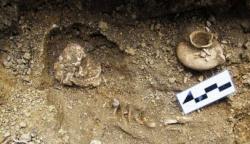 Poza Rica - Le centre INAH du Veracruz annonce la découverte d'une tombe préhispanique. Ce sont les habitants d'un quartier de cette ville qui, au moment de commencer la construction d'une maison se sont retrouvés nez à nez avec des pièces en céramique de style huastèque ou totonaque. Bien qu'en mauvaises conditions, les analyses préliminaires ont révélé qu'il s'agirait d'une femme enceinte enterrée en position foetale. Son âge n'a pas pu être encore déterminé. Elle aurait vécu vers 800 de notre ère, si on en croit la datation des céramiques qui l'accompagnaient comme offrande mortuaire.
Poza Rica - Le centre INAH du Veracruz annonce la découverte d'une tombe préhispanique. Ce sont les habitants d'un quartier de cette ville qui, au moment de commencer la construction d'une maison se sont retrouvés nez à nez avec des pièces en céramique de style huastèque ou totonaque. Bien qu'en mauvaises conditions, les analyses préliminaires ont révélé qu'il s'agirait d'une femme enceinte enterrée en position foetale. Son âge n'a pas pu être encore déterminé. Elle aurait vécu vers 800 de notre ère, si on en croit la datation des céramiques qui l'accompagnaient comme offrande mortuaire.
http://mexiqueancien.blogspot.fr/
SOUDAN – 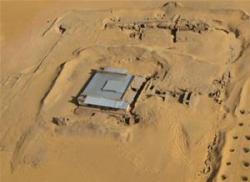
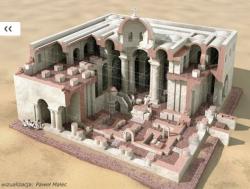 Banganarti - At the turn of 2011/2012, Polish scientists secured medieval paintings in the so-called Raphelion, or religious buildings dedicated to the Archangel Raphael in Banganarti, Sudan. This unique church building from mid-eleventh century was an important pilgrimage centre of in the Christian kingdom Makurii until mid-fourteenth century. Necessary conservation work was possible wilt financial support of PKN Orlen. "In addition to conservation, we have also performed restoration and protection work. W stabilised substrate layers, exterminated insects feeding in the layer of plaster, and cleaned and preserved the colour scheme of the most important paintings" - said Dr. Bogdan T. Żurawski from the Department of African Cultures of the Institute of Mediterranean and Oriental Cultures PAS, head of research. Work in Banganarti is conducted under a concession of the Centre of Mediterranean Archaeology of the University of Warsaw. Moreover, in the chapel of the holy healers Cosma and Damian, using the strip belt method (not destroying the inscriptions on the walls) Polish conservators unveiled earlier paintings. This allowed Nubian wall painting experts to look at the previously covered iconographic themes.
Banganarti - At the turn of 2011/2012, Polish scientists secured medieval paintings in the so-called Raphelion, or religious buildings dedicated to the Archangel Raphael in Banganarti, Sudan. This unique church building from mid-eleventh century was an important pilgrimage centre of in the Christian kingdom Makurii until mid-fourteenth century. Necessary conservation work was possible wilt financial support of PKN Orlen. "In addition to conservation, we have also performed restoration and protection work. W stabilised substrate layers, exterminated insects feeding in the layer of plaster, and cleaned and preserved the colour scheme of the most important paintings" - said Dr. Bogdan T. Żurawski from the Department of African Cultures of the Institute of Mediterranean and Oriental Cultures PAS, head of research. Work in Banganarti is conducted under a concession of the Centre of Mediterranean Archaeology of the University of Warsaw. Moreover, in the chapel of the holy healers Cosma and Damian, using the strip belt method (not destroying the inscriptions on the walls) Polish conservators unveiled earlier paintings. This allowed Nubian wall painting experts to look at the previously covered iconographic themes.
http://egyptology.blogspot.fr/
ITALIE – 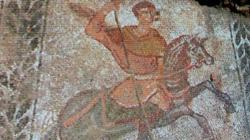 Oratorio delle Muriccia - La fouille d'une villa romaine du IVe a conduit à la découverte d'une remarquable mosaïque.
Oratorio delle Muriccia - La fouille d'une villa romaine du IVe a conduit à la découverte d'une remarquable mosaïque.
http://www.lanazione.it/empoli/cronaca/2012/05/26/718830-antico-mosaico-scoperto.shtml
FRANCE – 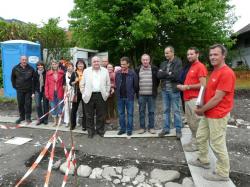 Thyez - Suite à la demande d’un permis de construire pour un terrain situé à une cinquantaine de mètres de l’église, route du Plan, les archéologues de l’Inrap ont mis à jour des vestiges avec traces d’occupations humaines pouvant dater d’un à trois siècles après J-C. Selon ces experts, la disparition du site pourrait provenir d’inondations successives. Ces vestiges ne sont pas les premiers à être découverts à cet endroit, les différentes constructions d’immeubles antérieurs ayant déjà révélé des traces évidentes d’une vie passée.
Thyez - Suite à la demande d’un permis de construire pour un terrain situé à une cinquantaine de mètres de l’église, route du Plan, les archéologues de l’Inrap ont mis à jour des vestiges avec traces d’occupations humaines pouvant dater d’un à trois siècles après J-C. Selon ces experts, la disparition du site pourrait provenir d’inondations successives. Ces vestiges ne sont pas les premiers à être découverts à cet endroit, les différentes constructions d’immeubles antérieurs ayant déjà révélé des traces évidentes d’une vie passée.
http://www.ledauphine.com/haute-savoie/2012/06/15/encore-des-vestiges-decouverts-pres-de-l-eglise
CANADA – 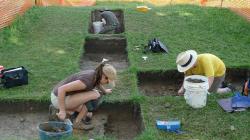 Fort Erié - In the summer and fall of 1814, this was the scene of a long and bloody battle with roughly 1,500 casualties, much of it played out along a 700-metre stretch of earthworks that the invading Americans had constructed westward from the fort itself, which they by then possessed. After retreating from the Battle of Lundy’s Lane, the Americans had resolved to dig in here and hold at least a sliver of Upper Canada. So they constructed a massive earth barricade, with a ditch at its foot, and 14 so-called traverses — additional earthen protection running back, perpendicular to the main barricade. Out front, they installed a tangle of sharpened stakes and completely cleared the land of all trees for 300 metres beyond that. If the British and Canadians and their Indians allies were going to come calling, they’d have to do so in the open. Most of the earthworks have long since been bulldozed almost flat, and perhaps half the original line is now covered with tall oak, willow and cottonwood. But while the fort itself has been completely restored, what caught Triggs’s attention was something that isn’t here, yet appears on British and American maps from the period: A narrow building, perhaps a third of the way along the earthworks. To the west of the fort, 20 archeology students from Laurier are hunched over precise plots, measuring 1 metre by 3, like miniature graves. For four weeks now they’ve been meticulously removing earth, layer by layer, until they hit hard clay, revealing the contour of the original earthworks. Along the way, they’re carefully recording what they find, where, and at what level. Although the plots are only a tiny fraction of the original American lines, the students have already come up with scores of musket balls and buckshot, the remains of British mortar bombs and U.S. army buttons.
Fort Erié - In the summer and fall of 1814, this was the scene of a long and bloody battle with roughly 1,500 casualties, much of it played out along a 700-metre stretch of earthworks that the invading Americans had constructed westward from the fort itself, which they by then possessed. After retreating from the Battle of Lundy’s Lane, the Americans had resolved to dig in here and hold at least a sliver of Upper Canada. So they constructed a massive earth barricade, with a ditch at its foot, and 14 so-called traverses — additional earthen protection running back, perpendicular to the main barricade. Out front, they installed a tangle of sharpened stakes and completely cleared the land of all trees for 300 metres beyond that. If the British and Canadians and their Indians allies were going to come calling, they’d have to do so in the open. Most of the earthworks have long since been bulldozed almost flat, and perhaps half the original line is now covered with tall oak, willow and cottonwood. But while the fort itself has been completely restored, what caught Triggs’s attention was something that isn’t here, yet appears on British and American maps from the period: A narrow building, perhaps a third of the way along the earthworks. To the west of the fort, 20 archeology students from Laurier are hunched over precise plots, measuring 1 metre by 3, like miniature graves. For four weeks now they’ve been meticulously removing earth, layer by layer, until they hit hard clay, revealing the contour of the original earthworks. Along the way, they’re carefully recording what they find, where, and at what level. Although the plots are only a tiny fraction of the original American lines, the students have already come up with scores of musket balls and buckshot, the remains of British mortar bombs and U.S. army buttons.
http://www.thestar.com/news/canada/article/1209640--fort-erie-dig-reveals-trove-of-artifacts-from-war-of-1812
CHINE – Yinxu - A new exhibition displaying rare cultural relics unearthed in Anyang, in Central China's Henanprovince, opened at the Shaanxi History Museum. Xi'an is the capital of Northwest China's Shaanxi province. Co-sponsored by the Archaeology Institute of the Chinese Academy of Social Sciences and the Shaanxi History Museum, the three-month exhibition displays 135 pieces of rare relics, whichshow the royal life of the Shang Dynasty (16th -11th century BC). The exhibits - such as royal bronze, jade and oracle pieces - were all unearthed by thearchaeology institute in the past 60 years in Anyang, known as Yinxu in ancient times and thecapital of the Shang Dynasty for more than 250 years. Chinese archaeologists made the first excavation in Yinxu in 1928. Since then more than130,000 pieces of oracle bones were found at the site. In the last 60 years, the archaeology institute made continuous efforts to excavate the site andfound a large number of rare relics including a large bronze tripod weighing 875 kg, whichshows the heyday of the Chinese bronze civilization. In July 2006, the Yinxu site was listed as a World Heritage site by the UNESCO World HeritageCommittee.
http://www.chinadaily.com.cn/china/2012-06/15/content_15506058.htm